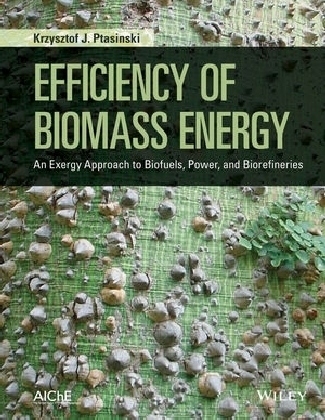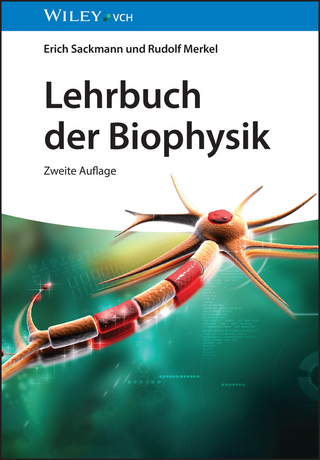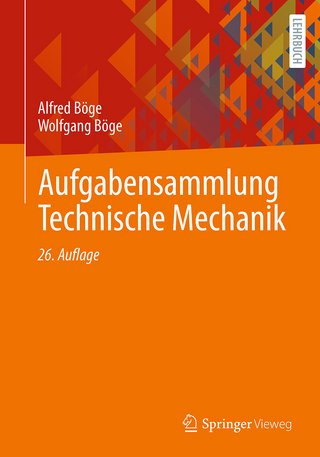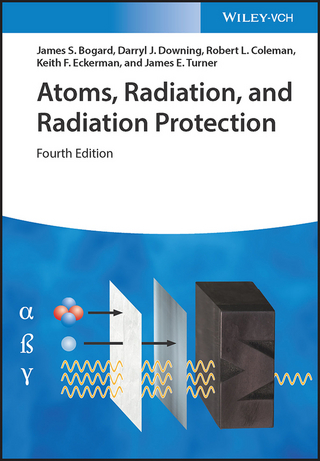
Efficiency of Biomass Energy
John Wiley & Sons Inc (Verlag)
978-1-118-70210-9 (ISBN)
- Titel z.Zt. nicht lieferbar
- Versandkostenfrei innerhalb Deutschlands
- Auch auf Rechnung
- Verfügbarkeit in der Filiale vor Ort prüfen
- Artikel merken
Covers all major bioenergy processes starting from photosynthesis and cultivation of biomass feedstocks and ending with final bioenergy products, like power, biofuels, and chemicals
Each chapter includes historical developments, chemistry, major technologies, applications as well as energy, environmental and economic aspects in order to serve as an introduction to biomass and bioenergy
A separate chapter introduces a beginner in easy accessible way to exergy analysis and the similarities and differences between energy and exergy efficiencies are underlined
Includes case studies and illustrative examples of 1st, 2nd, and 3rd generation biofuels production, power and heat generation (thermal plants, fuel cells, boilers), and biorefineries
Traditional fossil fuels-based technologies are also described in order to compare with the corresponding bioenergy systems
Krzysztof J. Ptasinski, Ph.D., D.Sc., has over 40 years of experience in academic teaching and research in chemical engineering and energy technology. He has held appointments at the Eindhoven University of Technology and the University of Twente (the Netherlands) as well as the Warsaw University of Technology and as visiting professor at the Silesian University of Technology (Poland). His pioneering research on application of exergy analysis to biomass and bioenergy is internationally acclaimed. He is the author and co-author of more than 200 publications, including 19 book chapters and 75 research papers. Currently he serves as an Executive Editor Biomass and Bioenergy – Energy, The International Journal.
Preface xv
Acknowledgments xix
About the Author xxi
PART I | Background and Outline
Chapter 1 | Bioenergy Systems: An Overview 3
1.1 Energy and the Environment 3
1.2 Biomass as a Renewable Energy Source 13
1.3 Biomass Conversion Processes 22
1.4 Utilization of Biomass 27
1.5 Closing Remarks 34
References 34
Chapter 2 | Exergy Analysis 37
2.1 Sustainability and Efficiency 37
2.2 Thermodynamic Analysis of Processes 42
2.3 Exergy Concept 52
2.4 Exergetic Evaluation of Processes and Technologies 67
2.5 Renewability of Biofuels 81
2.6 Closing Remarks 86
References 86
PART II | Biomass Production and Conversion
Chapter 3 | Photosynthesis 93
3.1 Photosynthesis: An Overview 93
3.2 Exergy of Thermal Radiation 99
3.3 Exergy Analysis of Photosynthesis 106
3.4 Global Photosynthesis 116
3.5 Closing Remarks 120
References 120
Chapter 4 | Biomass Production 123
4.1 Overview 123
4.2 Efficiency of Solar Energy Capture 133
4.3 Fossil Inputs for Biomass Cultivation and Harvesting 140
4.4 Fossil Inputs for Biomass Logistics 146
4.5 Closing Remarks 150
References 150
Chapter 5 | Thermochemical Conversion: Gasification 153
5.1 Gasification: An Overview 153
5.2 Gasification of Carbon 171
5.3 Gasification of Biomass 183
5.4 Gasification of Typical Fuels 191
5.5 Closing Remarks 198
References 198
Chapter 6 | Gasification: Parametric Studies and Gasification Systems 203
6.1 Effect of Fuel Chemical Composition on Gasification Performance 203
6.2 Effect of Biomass Moisture Content, Gasification Pressure, and Heat Addition on Gasification Performance 211
6.3 Improvement of Gasification Exergetic Efficiency 215
6.4 Gasification Efficiency Using Equilibrium versus Nonequilibrium Models 230
6.4.1 Quasi-Equilibrium Thermodynamic Models 231
6.4.2 Comparison of Gasification Efficiency 231
6.5 Performance of Typical Gasifiers 233
6.5.1 Comparison of FICFB and Viking Gasifiers 233
6.5.2 Fluidized-Bed Gasifiers for the Production of H2-Rich Syngas 238
6.5.3 Downdraft Fixed-Bed Gasifier 241
6.5.4 Updraft Fixed-Bed Gasifier 242
6.6 Plasma Gasification 244
6.6.1 Plasma Gasification Technology 244
6.6.2 Plasma Gasification of Sewage Sludge 244
6.7 Thermochemical Conversion in Sub- and Supercritical Water 246
6.7.1 Conversion of Wet Biomass in Hot Compressed Water 246
6.7.2 Supercritical Water Gasification (SCWG) 247
6.7.3 Hydrothermal Upgrading (HTU) under Subcritical Water Conditions 251
6.8 Closing Remarks 253
References 253
PART III | Biofuels First-Generation Biofuels
Chapter 7 | Biodiesel 261
7.1 Biodiesel: An Overview 261
7.1.1 Introduction 261
7.1.2 Historical Development 262
7.1.3 Chemistry 263
7.1.4 Feedstocks 265
7.1.5 Production Process 266
7.1.6 Biodiesel as Transport Fuel 268
7.1.7 Energy, Environmental, and Economic Performance 269
7.2 Biodiesel from Plant Oils 272
7.2.1 Exergy Analysis of Transesterification 272
7.2.2 Exergy Analysis of Overall Production Chain 275
7.3 Biodiesel from Used Cooking Oil 278
7.3.1 Exergy Analysis of Biodiesel Production 278
7.3.2 Exergy Analysis of Overall Production Chain 281
7.4 Biodiesel from Microalgae 281
7.4.1 Introduction 281
7.4.2 Exergy Analysis of Transesterification of Algal Oil 282
7.4.3 Exergy Analysis of Overall Production Chain of Algal Biodiesel 284
7.5 Closing Remarks 286
References 286
Chapter 8 | Bioethanol 289
8.1 Bioethanol: An Overview 289
8.1.1 Introduction 289
8.1.2 Historical Development 290
8.1.3 Ethanol as Transport Fuel 291
8.1.4 Chemistry 293
8.1.5 Bioethanol Production Methods 295
8.1.6 Energy, Environmental and Economic Aspects 302
8.2 Exergy Analysis of Ethanol from Sugar Crops 305
8.2.1 Introduction 305
8.2.2 Ethanol from Sugarcane 306
8.2.3 Exergetic Performance of Sugarcane Ethanol Plants for Various Cogeneration Configurations 310
8.2.4 Ethanol from Sugar Beets 313
8.2.5 Renewability of Ethanol from Sugar Crops 315
8.3 Exergy Analysis of Ethanol from Starchy Crops 317
8.3.1 Introduction 317
8.3.2 Corn Ethanol: Exergy Analysis 317
8.3.3 Corn Ethanol: Cumulative Exergy Consumption (CExC) and Renewability 319
8.3.4 Wheat Ethanol 322
8.4 Exergy Analysis of Lignocellulosic Ethanol (Second Generation) 323
8.4.1 Introduction 323
8.4.2 Ethanol from Wood (NREL Process) 324
8.4.3 Impact of Biomass Pretreatment and Process Configuration 328
8.4.4 Comparison of Exergetic Efficiency 330
8.4.5 Renewability of Lignocellulosic Ethanol from Tropical Tree Plantations 331
8.5 Alternative Ethanol Processes 332
8.5.1 Fossil Ethanol from Mineral Oil 332
8.5.2 Ethanol via Water Electrolysis 333
8.6 Closing Remarks 334
References 334
Second-Generation Liquid Biofuels
Chapter 9 | Fischer–Tropsch Fuels 341
9.1 Fischer–Tropsch Synthesis: An Overview 341
9.1.1 Introduction 341
9.1.2 Historical Development 342
9.1.3 Process Chemistry 343
9.1.4 Comparison of F-T Fuels to Conventional Transport Fuels 345
9.1.5 Process Design 346
9.1.6 Process Performance 348
9.2 Exergy Analysis of Coal-to-Liquid (CTL) Process 351
9.2.1 Description of CTL Process 351
9.2.2 Mass Balance and Energy Analysis 353
9.2.3 Exergy Analysis 354
9.3 Exergy Analysis of Gas-to-Liquid (GTL) Processes 355
9.3.1 GTL Process with Tail Gas Recycling: Internal and External 356
9.3.2 Impact of Reformer Temperature on GTL Efficiency: External Tail Gas Recycling 361
9.4 Exergy Analysis of Biomass-to-Liquid (BTL) Processes 365
9.4.1 Introduction 365
9.4.2 Once-Through F-T Process 366
9.4.3 Impact of Biomass Feedstock on Process Efficiency 373
9.4.4 Reforming and Recycling of F-T Reactor Tail Gas 377
9.4.5 Recycling of F-T Reactor Tail Gas to Biomass Gasifier 382
9.5 Closing Remarks 383
References 383
Chapter 10 | Methanol 387
10.1 Methanol: An Overview 387
10.1.1 Introduction 387
10.1.2 Historical Development 388
10.1.3 Chemistry 389
10.1.4 Methanol as Transport Fuel 390
10.1.5 Process Design 392
10.1.6 Process Performance 393
10.2 Methanol from Fossil Fuels 396
10.2.1 Methanol from Natural Gas 396
10.2.2 Methanol from Coal 400
10.3 Methanol from Biomass 405
10.3.1 Methanol from Waste Biomass (Sewage Sludge) 405
10.3.2 Other Biomass-Based Methanol Processes 413
10.4 Closing Remarks 414
References 415
Chapter 11 | Thermochemical Ethanol 419
11.1 Thermochemical Ethanol: An Overview 419
11.1.1 Introduction 419
11.1.2 Process Chemistry 420
11.1.3 Catalysts for Ethanol Synthesis 422
11.1.4 Process Design 423
11.1.5 Energy, Environmental and Economic Aspects 426
11.2 Exergy Analysis 427
11.2.1 Process Description 428
11.2.2 Mass and Energy Balances (Rh-Based Catalyst) 431
11.2.3 Exergy Analysis (Rh-Based Catalyst) 433
11.2.4 Impact of Ethanol Synthesis Catalyst (MoS2-Based Target Catalyst) 435
11.2.5 Impact of Gasification Temperature 438
11.3 Closing Remarks 439
References 440
Chapter 12 | Dimethyl Ether (DME) 445
12.1 Dimethyl Ether: An Overview 445
12.1.1 Introduction 445
12.1.2 Historical Development 446
12.1.3 Process Chemistry 447
12.1.4 DME as Energy Carrier 448
12.1.5 Production Technology 449
12.1.6 Energy, Environmental, and Economic Aspects 451
12.2 Dimethyl Ether from Fossil Fuels 452
12.2.1 DME from Natural Gas 452
12.2.2 DME from Coal 458
12.2.3 DME from Co-Feed of Natural Gas and Coal 462
12.3 Dimethyl Ether from Biomass 462
12.3.1 DME via Indirect Steam Gasification 462
12.3.2 Influence of Syngas Preparation Method on Process Efficiency 468
12.4 Closing Remarks 472
References 472
Chapter 13 | Hydrogen 475
13.1 Hydrogen: An Overview 475
13.1.1 Introduction 475
13.1.2 History: from Discovery to Hydrogen Economy 476
13.1.3 Chemistry of Hydrogen Production 477
13.1.4 Hydrogen Use 479
13.1.5 Hydrogen Storage 480
13.1.6 Production Methods 481
13.1.7 Energy, Environmental, and Economic Performance 482
13.2 Exergy Analysis of Hydrogen from Fossil Fuels 485
13.2.1 Hydrogen from Natural Gas 485
13.2.2 Comparison of Efficiency for Hydrogen-from-Natural Gas Processes 489
13.2.3 Hydrogen-from-Coal Gasification 490
13.2.4 Comparison of Efficiency for Hydrogen-from-Coal Processes 493
13.3 Exergy Analysis of Hydrogen from Water Electrolysis 494
13.3.1 Process Description 494
13.3.2 Mass and Energy Balances 495
13.3.3 Exergy Analysis 495
13.4 Exergy Analysis of Future Hydrogen Production Processes 496
13.4.1 Thermochemical Cycles 497
13.4.2 Geothermal Energy 499
13.4.3 Solar Energy 500
13.5 Exergy Analysis of Hydrogen Production from Biomass Gasification 501
13.5.1 Exergy Analysis of Hydrogen from Wood 501
13.5.2 Influence of Biomass Feedstocks on Exergetic Efficiency 506
13.5.3 Influence of Gasification System Configurations on Exergetic Efficiency 507
13.5.4 Comparison of Efficiency for Hydrogen-from-Biomass Gasification 511
13.6 Exergy Analysis of Biological Hydrogen Production 512
13.6.1 Process Description 512
13.6.2 Mass and Energy Balances 514
13.6.3 Exergy Analysis 515
13.7 Closing Remarks 517
References 517
Chapter 14 | Substitute Natural Gas (SNG) 523
14.1 Substitute Natural Gas: An Overview 523
14.1.1 Introduction 523
14.1.2 Historical Development 524
14.1.3 Chemistry of Methanation 526
14.1.4 Natural Gas as Energy Carrier 527
14.1.5 SNG Production Technology 529
14.1.6 Energy, Environmental and Economic Aspects 530
14.2 SNG from Coal 533
14.2.1 Description of Coal-to-SNG Process 533
14.2.2 Process Modeling 537
14.2.3 Mass and Energy Balances 537
14.2.4 Exergy Analysis 538
14.2.5 Overview of Coal-to-SNG Processes 540
14.3 SNG from Biomass Gasification 540
14.3.1 SNG via Wood Gasification 540
14.3.2 Comparison of SNG Production from Various Biomass Feedstocks 550
14.3.3 Overview of Biomass-to-SNG Processes 555
14.4 Closing Remarks 555
References 556
PART IV | Bioenergy Systems
Chapter 15 | Thermal Power Plants, Heat Engines, and Heat Production 561
15.1 Biomass-Based Power and Heat Generation: An Overview 561
15.1.1 Introduction 561
15.1.2 Historical Development 563
15.1.3 Technologies for Power Generation from Biomass 564
15.1.4 Biofuels in Internal Combustion Engines and Gas Turbines 567
15.1.5 Biomass Heating Systems 568
15.1.6 Performance and Cost of Power Generation Systems 569
15.1.7 Environmental Aspects 571
15.2 Biomass Combustion Power Systems 571
15.2.1 Introduction 571
15.2.2 Biomass Steam Cogeneration Plant 572
15.2.3 Externally Fired Gas Turbine–Combined Cycle 575
15.2.4 Biomass-Fired Organic Rankine Cycle (ORC) 580
15.3 Biomass Gasification Power Systems 584
15.3.1 Introduction 584
15.3.2 Biomass Integrated Gasification Gas Turbine–Combined Cycle (BIG/GT-CC) 585
15.3.3 Improving Efficiency BIG/GT-CC Plants 588
15.3.4 Biomass Integrated Gasification Internal Combustion Engine–Combined Cycle (BIG/ICE-CC) 589
15.4 Comparison of Various Biomass-Fueled Power Plants 591
15.4.1 Internally and Externally Fired Gas Turbine Simple Cogeneration Cycles 592
15.4.2 Internally and Externally Fired Gas Turbine: Simple and Combined Cycles 597
15.4.3 Comparison of Biomass Combustion and Gasification CHP Plants 602
15.5 Biomass-Fueled Internal Combustion Engines and Gas Turbines 608
15.5.1 Ethanol-Fueled Spark-Ignition Engines 609
15.5.2 Biodiesel-Fueled Compression-Ignition Engines 610
15.5.3 Biofuel-Fired Gas Turbines 612
15.6 Polygeneration of Electricity, Heat, and Chemicals 615
15.6.1 Introduction 615
15.6.2 Methanol Synthesis 615
15.6.3 Ethanol Production 621
15.7 Biomass Boilers and Heating Systems 624
15.7.1 Introduction 624
15.7.2 Biomass Boilers 625
15.7.3 Energy Utilization in Buildings 627
15.8 Closing Remarks 628
References 628
Chapter 16 | Biomass-Based Fuel Cell Systems 633
16.1 Biomass-Based Fuel Cell Systems: An Overview 633
16.1.1 Introduction 633
16.1.2 Historical Development 634
16.1.3 Fuel Cell Fundamentals 635
16.1.4 Fuel Cell Types 636
16.1.5 Fuel Cell Thermodynamics 638
16.1.6 Overview of Biomass-Based Fuel Cell Configurations 640
16.1.7 Energy Efficiency, Cost, and Environmental Impact 642
16.2 Biomass Integrated Gasification–Solid Oxide Fuel Cell (BIG/SOFC) Systems 642
16.2.1 Central Power Production Using BIG/SOFC/GT Systems 643
16.2.2 Other Central Power Production Studies Using BIG/SOFC Systems 647
16.2.3 Distributed Power Production Using BIG/SOFC Systems 648
16.2.4 Integration of Supercritical Water Gasification (SCWG) with SOFC/GT Hybrid System 650
16.3 Biomass Integrated Gasification–Proton Exchange Membrane Fuel Cell (BIG/PEMFC) Systems 652
16.3.1 Distributed Combined Heat and Power Generation Based on Central Hydrogen Production 652
16.3.2 Effect of Hydrogen Quality on Efficiency of Distributed CHP Systems 659
16.4 Fuel Cell Systems Fed with Liquid Biofuels 660
16.4.1 Introduction 660
16.4.2 Maximum Electricity Obtainable from Various Fuels 661
16.4.3 Integrated Fuel Processor–Fuel Cell (FP-FC) System 663
16.4.4 Direct Liquid Fuel Cell Systems 668
16.5 Closing Remarks 669
References 669
Chapter 17 | Biorefineries 673
17.1 Biorefineries: An Overview 673
17.1.1 Introduction 673
17.1.2 Historical Development 674
17.1.3 Chemical Value of Biomass 675
17.1.4 Biorefinery Systems 677
17.1.5 Biorefinery Technology 679
17.2 Comparison of Various Biomass Utilization Routes 681
17.2.1 Biomass Utilization Routes 681
17.2.2 Power Generation 682
17.2.3 Biofuels Production 683
17.2.4 Chemical Biorefinery 683
17.3 Exergy Inputs to Basic Biorefinery Steps 684
17.3.1 Biorefinery Model 684
17.3.2 Processing Simple Carbohydrates into Fermentable Sugars 686
17.3.3 Processing Complex Carbohydrates into Fermentable Sugars 686
17.3.4 Processing Fermentable Sugars into Ethanol 688
17.3.5 Processing Ethanol into Ethylene 689
17.3.6 Fatty Acids Processing 690
17.3.7 Amino Acids Processing 692
17.3.8 Lignin Processing 695
17.3.9 Ash and Residuals Processing 695
17.4 Optimal Biomass Crops as Biorefinery Feedstock 696
17.4.1 Biomass versus Petrochemical Route for the Production of Bulk Chemicals 696
17.4.2 Cumulative Fossil Fuel Consumption in the Biomass Route 697
17.4.3 Cumulative Fossil Fuel Consumption in the Petrochemical Route 698
17.4.4 Fossil Fuel Savings 699
17.4.5 Optimal Crops for Biorefineries 699
17.5 Closing Remarks 702
References 702
Postface 707
Appendixes
Appendix A – Conversion Factors 709
Appendix B – Constants 711
Appendix C – SI Prefixes 713
Glossary of Selected Terms 715
Notation 721
Acknowledgments for Permission to Reproduce Copyrighted Material 729
Author Index 733
Subject Index 745
| Verlagsort | New York |
|---|---|
| Sprache | englisch |
| Maße | 216 x 282 mm |
| Gewicht | 1996 g |
| Themenwelt | Geisteswissenschaften ► Geschichte |
| Naturwissenschaften ► Chemie | |
| Naturwissenschaften ► Physik / Astronomie ► Angewandte Physik | |
| Technik ► Elektrotechnik / Energietechnik | |
| Technik ► Umwelttechnik / Biotechnologie | |
| ISBN-10 | 1-118-70210-7 / 1118702107 |
| ISBN-13 | 978-1-118-70210-9 / 9781118702109 |
| Zustand | Neuware |
| Informationen gemäß Produktsicherheitsverordnung (GPSR) | |
| Haben Sie eine Frage zum Produkt? |
aus dem Bereich


